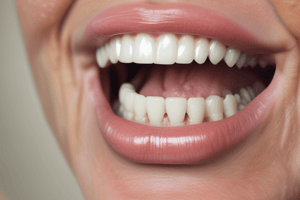Podcast
Questions and Answers
What is the characteristic feature of skin fibrosis in late systemic sclerosis?
What is the characteristic feature of skin fibrosis in late systemic sclerosis?
- Increased number of rete pegs
- Thickening of the epidermis
- Absence of inflammation (correct)
- Presence of perivascular mononuclear cell infiltrates
Which of the following is true about the dermis in systemic sclerosis?
Which of the following is true about the dermis in systemic sclerosis?
- Collagen bundles are oriented perpendicular to the epithelium (correct)
- Adnexal glands are hypertrophic
- There is an increase in white adipose tissue
- The dermis is atrophic
What happens to the adnexal glands in systemic sclerosis?
What happens to the adnexal glands in systemic sclerosis?
- They become hyperpigmented
- They become hypertrophic
- They show increased inflammation
- They atrophy (correct)
What is the main cellular component found in early perivascular infiltrates in systemic sclerosis?
What is the main cellular component found in early perivascular infiltrates in systemic sclerosis?
What is the state of rete pegs in systemic sclerosis compared to normal skin?
What is the state of rete pegs in systemic sclerosis compared to normal skin?
What is the result of progressive thickening of alveolar septae in lung disease?
What is the result of progressive thickening of alveolar septae in lung disease?
Which of the following cell types is NOT typically found in the early disease stage of lung involvement?
Which of the following cell types is NOT typically found in the early disease stage of lung involvement?
What is the consequence of vascular damage in the progression of lung disease?
What is the consequence of vascular damage in the progression of lung disease?
What happens as a result of the loss of pulmonary vessels in the context of lung involvement?
What happens as a result of the loss of pulmonary vessels in the context of lung involvement?
What is the ultimate consequence of the obliteration of airspaces and honeycombing in lung disease?
What is the ultimate consequence of the obliteration of airspaces and honeycombing in lung disease?
Flashcards are hidden until you start studying



